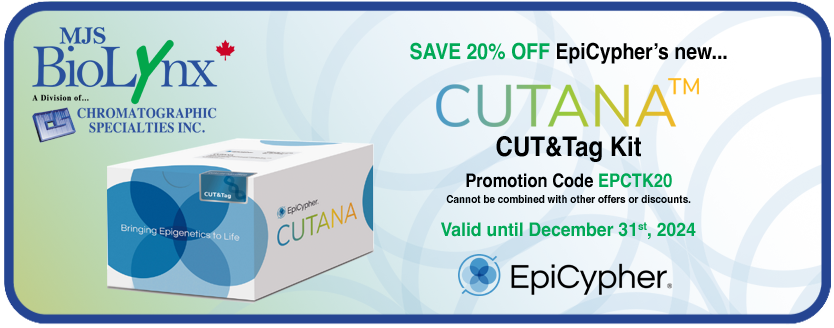EpiCypher® – What's New with CUT&Tag?

What’s new with CUT&Tag? Seven FAQs you need to read...
Katherine Novitzky, MS and Ellen N. Weinzapfel, PhD
From single cell profiling and spatial epigenomics to analysis of FFPE samples, CUT&Tag is making headlines1-7. CUT&Tag is also a major R&D focus at EpiCypher. Over the years our team has developed and optimized multiple epigenomic mapping assays, including CUT&Tag, CUT&RUN, and ChIP-seq. The CUTANA™ CUT&Tag Kit leverages our expertise, making this incredible technology accessible to more research areas and labs worldwide. Version 2 of the CUTANA™ CUT&Tag Kit is now available and better than ever before.
On its surface, CUT&Tag is remarkably simple8,9. A fusion of Protein A/G tethers a hyperactive Tn5 transposase at antibody-labelled chromatin. Activated Tn5 inserts sequencing adapters and cleaves DNA, a process known as tagmentation. In EpiCypher’s Direct-to-PCR approach, tagmented DNA is directly amplified from the reaction mixture using primers that recognize the adapter sequences, bypassing library prep and increasing sensitivity for low cell numbers. The entire assay is performed using intact nuclei bound to magnetic beads and is optimized for 8-strip tubes, enabling high-throughput workflows and automated solutions.
For a streamlined experience we developed the CUTANA™ CUT&Tag Kit, which includes everything needed to go from cells to purified sequencing libraries. Note that CUT&Tag is only recommended for mapping histone post-translational modifications (PTMs). To learn more about when to use CUT&Tag versus its sister technology CUT&RUN, read this blog post.
Despite these advances, CUT&Tag remains a challenging epigenomic assay. To make the protocol more robust, EpiCypher continuously tests the CUTANA™ CUT&Tag protocol, investigating different buffer components, tweaking reaction conditions, and testing additional cell types. Version 2 of the CUTANA™ CUT&Tag Kit reflects recent optimizations by our scientists. To learn more about these updates, we chatted with Katherine Novitzky, M.S., who played a key role in the cross-team collaborative effort to improve the CUTANA™ CUT&Tag Kit user experience.
Why are people interested in CUT&Tag?
People are really interested in CUT&Tag because it allows scientists to streamline our workflows without sacrificing the quality of data. This was never possible when using ChIP, and since CUT&Tag arrived on the scene, we have finally been able to develop higher throughput chromatin mapping assays. Compared to ChIP-seq we can use fewer cells, spend less time at the bench, multiplex more reactions for sequencing, and generate higher resolution data.
Why is CUT&Tag so much faster compared to ChIP-seq and CUT&RUN?
CUT&Tag is faster than other chromatin mapping techniques for a variety of reasons. From a sample perspective, time is no longer spent optimizing cell lysis, cross-linking, and/or chromatin fragmentation. CUT&Tag uses intact nuclei, which can be harvested from fresh or frozen native cells in under 15 minutes. Nuclei are then bound to a solid support (magnetic ConA beads) which limits sample loss and lets you perform washes quickly using magnetic racks. This feature makes the protocol compatible with 8-strip tubes, further accelerating the workflow.
From a protocol perspective, the direct insertion of sequencing adapters cuts out the need for standard library prep, removing a day of bench work and reducing sample loss. While most CUT&Tag protocols require you to purify DNA and then perform PCR, EpiCypher’s Direct-to-PCR strategy allows you to amplify tagmented DNA directly from the CUT&Tag reaction. You add your indexing primers and PCR mix directly to the CUT&Tag reaction tubes, because it is all performed in 8-strip tubes. For time-sensitive projects, you can load the sequencer at the end of day 2 of CUT&Tag and begin processing data as early as day 3. That kind of turn-around time is invaluable.
Why can you use fewer cells in CUT&Tag compared to ChIP-seq?
Low starting cell numbers are possible in CUT&Tag due to the streamlined workflow and reduced background. In ChIP-seq, cross-linking and chromatin sonication or fragmentation are needed to prepare input chromatin. In the immunoprecipitation (IP) step, an antibody is added to this pool of fragmented chromatin. Ideally the antibody will only bind the target, but the IP almost always recovers off-target fragments and introduces background or artifacts in sequencing data. Scientists normally increase the number of cells to overcome background and improve data quality, but this tactic ultimately limits low-cell applications.
CUT&Tag is performed using intact nuclei coupled to magnetic beads and does not require a traditional IP step, reducing background. Our method also bypasses multiple DNA purification steps in ChIP and standard library prep, which helps limit sample loss. Combined, you can start out with about 10-fold less material in CUT&Tag compared to ChIP-seq, which is pretty incredible.
What are the most common problems scientists have with the CUT&Tag protocol?
The main problems I've noticed with the CUT&Tag protocol are low to no yields, which can be caused by any number of variables. Low yields often result from poor sample prep, sample loss during experiments, problems with ConA beads, and issues with reaction mixing. These problems are all related, making it complicated to address.
Most often I tend to look at the starting cells; “garbage in, garbage out” is a common phrase for CUT&Tag experiments at EpiCypher, and it’s true! We always perform quality control analysis of starting cells, harvested nuclei, and nuclei bound to ConA beads. Signs of a bad sample prep are lysed cells, debris in your nuclei prep, or unbound nuclei present in the supernatant after ConA bead binding. If any of that is flagged, the material may not make it to tagmentation.
Insufficient mixing is also a frequent cause of low yields. Keeping beads in solution is essential to assay success: it helps ensure even distribution of antibodies and pAG-Tn5 and supports efficient indexing PCR. However, on Day 2 of the protocol, the ConA bead slurry can become sticky and difficult to resuspend, especially after tagmentation. While one should be gentle when handling material, failing to mix CUT&Tag reactions will destroy yields. Our protocol has outlined in detail when and how to mix the samples, to consistently recover CUT&Tag generated libraries in the end.
How do the updates help?
These updates are focused on helping end users consistently generate high-quality CUT&Tag data. Our team discussed each step of the protocol in detail. Why is a buffer made with a certain component or pH? What is the impact on nuclei or cellular physiology? These questions helped us pinpoint where key improvements could be made.
Our rigorous characterization of pAG-Tn5 showed that enzyme itself wasn’t the problem; the tagmentation reaction was efficient. Instead, sample was being lost in the post-tagmentation steps. In response, we performed extensive head-to-head comparisons for sample handling, buffer composition, protocol steps, and tested the top contenders.
These experiments really lifted the veil on what is happening in vitro. Low salt concentration in the TAPS Buffer was causing osmotic changes and nuclei lysis. Mixing technique was also particularly important and was contributing to sample loss. For instance, after addition of SDS Release Buffer, the sample became sticky and impossible to pipette. In other parts of the protocol, vortexing led to sample loss due to material sticking to the sides of the tube.
Based on our experiments, we removed the low-salt TAPS Buffer wash following tagmentation and replaced it with Pre-Wash Buffer, which contains physiological salt, supporting nuclei integrity. In the protocol we also added very specific resuspending and mixing instructions to help guide users on best practices. In-house we asked EpiCypher colleagues to test our CUT&Tag protocol modifications and had improved success rates for both novice and experienced users, highlighting the utility of these CUT&Tag improvements.
Can scientists who are using Version 1 of the CUTANA™ CUT&Tag Kit or the DIY CUT&Tag Protocol apply these protocol changes?
Yes, absolutely. All protocol changes are compatible with Version 1 of the CUTANATM CUT&Tag Kit as well as the DIY CUT&Tag protocol. (Download the Version 2.0 manual here, under Documents and Resources.) Scientists can follow the protocol using their current kit – no new materials are required!
The main difference to note is that TAPS Wash Buffer has been removed from the kit. The post-tagmentation wash that used TAPS Buffer are performed using an equal volume of Pre-Wash Buffer. We supply kit users with ample Pre-Wash Buffer, so they should have plenty for this step.
What if people have additional questions about CUT&Tag?
The manual for our CUT&Tag Kit Version 2.0 is a comprehensive resource for all things CUT&Tag and may be able to address your questions.
If you have further questions, please contact the MJSBioLynx Tech Support Team.
Conclusions
The updates to the CUT&Tag Kit reflect rigorous EpiCypher R&D. They're continuing this research to refine both CUT&Tag and CUT&RUN, including optimization for new applications and research fields.
References:
- Janssens DH et al. Scalable single-cell profiling of chromatin modifications with sciCUT&Tag. Nat Protoc 19, 83-112 (2024). https://doi.org/10.1038/s41596-023-00905-9.
- Bartosovic M et al. Single-cell CUT&Tag profiles histone modifications and transcription factors in complex tissues. Nat Biotechnol 39, 825-35 (2021). https://doi.org/10.1038/s41587-021-00869-9.
- Wu SJ et al. Single-cell CUT&Tag analysis of chromatin modifications in differentiation and tumor progression. Nat Biotechnol 39, 819-24 (2021). https://www.doi.org/10.1038/s41587-021-00865-z.
- Deng Y et al. Spatial-CUT&Tag: Spatially resolved chromatin modification profiling at the cellular level. Science 375, 681-6 (2022). https://doi.org/10.1126/science.abg7216.
- Zhang D et al. Spatial epigenome-transcriptome co-profiling of mammalian tissues. Nature 616, 113-22 (2023). https://doi.org/10.1038/s41586-023-05795-1.
- Henikoff S et al. Direct measurement of RNA Polymerase II hypertranscription in cancer FFPE samples. bioRxiv 2024.02.28.582647 (2024). https://doi.org/10.1101/2024.02.28.582647.
- Henikoff S et al. Epigenomic analysis of formalin-fixed paraffin-embedded samples by CUT&Tag. Nat Commun 14, 5930 (2023). https://doi.org/10.1038/s41467-023-41666-z.
- Kaya-Okur HS et al. CUT&Tag for efficient epigenomic profiling of small samples and single cells. Nat Commun 10, 1930 (2019). https://doi.org/10.1038/s41467-019-09982-5.
- Kaya-Okur HS et al. Efficient low-cost chromatin profiling with CUT&Tag. Nat Protoc 15, 3264-83 (2020). https://doi.org/10.1038/s41596-020-0373-x.



